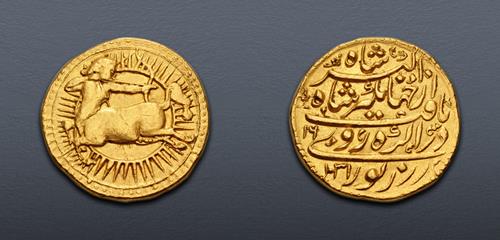|
INDIA, Mughal Empire. Nur al-Din Muhammad Jahangir. AH 1014-1037 / AD 1605-1627. AV Mohur (21mm, 10.62 g, 10h). Zodiac Type, Class A. Agra mint. Dated AH 1031 (16 November AD 1621 – 4 November AD 1622) and RY 16 (15/24 October AD 1620 – 14/23 October AD 1621). Constellation of Nemasp/Dhanusa (Sagittarius the Archer): centaur, head and upper torso right, galloping left, preparing to fire arrow from bow; radiate sun behind / zar zewar dar Agra ruye yaft az Jahangir Shah Akbar Shah (Received ornament on gold at Agra from Jahangir Shah [son of] Akbar Shah) in Persian verse; RY and AH dates to left. Liddle Type G-107 = Fitzwilliam Inv. (same dies); BM 348 = Hull 1401 = BM Inv. MAR.864 (same dies – same, or slightly later die state); IMC 581 = Hull 1402 (obv. only illustrated; same die); KM 180.17; Friedberg 770 (using illustration of BM coin); Adams III, lot 2046 (same dies – later die state). Lightly toned, hint of deposits in devices, minor cleaning marks, slight double strike. Good VF.
Ex Baron di Portanova Collection (Spink 172, 31 March 2005), lot 463.
Previously to this, the rule of the coinage was that on the face of the metal they stamped my name, and on the reverse the name of the place and the year of the reign. At this time it entered my mind that in place of the month they should substitute the figure of the constellation which belonged to that month...in each month that was struck, the figure of the constellation was to be on one face, as if the sun was emerging from it.
The Memoirs of Jahangir [Tuzk-e Jahangiri] (Entry for 20 March 1619)
In the 29th year of his reign, the Mughal emperor Akbar (1556-1605) established the Din-e Ilahi (literally faith of God), a syncretic belief system that incorporated elements of the different religious beliefs in his empire. Immediately thereafter, Akbar began counting his reign in accordance with the tenets this new belief system. Known as the Ilahi Era, dating was now based on a solar, rather than lunar, calendar with the year divided into twelve Ilahi months.
Akbar’s early successors continued to employ this dating system. Jahangir (1605-1628), Akbar’s son and immediate successor, used the Ilahi Era to great artistic effect by issuing two series of mohurs that incorporated Ilahi Era elements. The earliest series, known as the portrait series, since the coins show the emperor on the obverse, all show the constellation Leo superimposed over the sun – a reference to Jahangir’s birth in August. This series was struck within a three-year span early in Jahangir’s reign and are quite rare. The second series, known as the zodiac series, since each of the twelve constellations of the Zodiac is represented on the reverse, was a much larger series. Struck both in gold and silver, the zodiac series was issued from several mints (with Agra being the primary), and like the previous series, minted over three or four years. Since the Ilahi months were solar months and corresponded with the solar ecliptic (an imaginary line in the sky that marks the annual path of the sun), each month was represented by an appropriate sign of the Zodiac, recording its particular month of issue.
Because many of these coins had been recalled and melted by Jahangir’s successor, Shah Jahan, original strikes are very rare. Collector restrikes were periodically issued over the following century, and though they are more often encountered than the originals, are relatively rare themselves. Numismatists have divided the portrait and zodiac series mohurs into four classes:
Class A: undisputed original strikes, characterized by deep relief, somewhat uneven flans, and rounded calligraphy.
Class B: possibly original strikes, but more likely minted in the first decade or two following Jahangir’s death. The relief is shallower, of a more uniform appearance, and the calligraphy is more square.
Class C: mohurs of Class A or B that have had the zodiac type removed and re-engraved.
Class D: later imitations and forgeries.
May 2022. CNG 120 – Session Four – World Coinage through Antiquities will be held Thursday afternoon, 12 May 2022 beginning at 2:00 PM ET.
Winning bids are subject to a 20% buyer's fee for bids placed on this website and 22.50% for all others.
We recognize that our users may have various Internet Browsers and Operating Systems. We like our visitors to have the best possible experience when using our bidding platform. However, we do recognize that it is impossible to develop applications that work identically, efficiently and effectively on all web browsers. The CNG bidding platform supports the latest stable major version and the stable previous version of Mozilla Firefox and Chrome.
|
